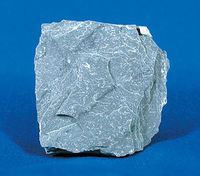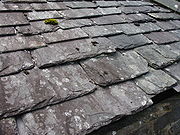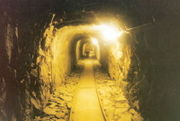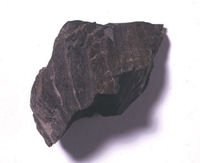Slate
| Slate | |
|---|---|
| — Metamorphic Rock — | |
 |
|
| Slate | |
| Composition | |
| Primary | quartz, muscovite/illite |
| Secondary | biotite, chlorite, hematite, pyrite |
Slate is a fine-grained, foliated, homogeneous metamorphic rock derived from an original shale-type sedimentary rock composed of clay or volcanic ash through low-grade regional metamorphism. The result is a foliated rock in which the foliation may not correspond to the original sedimentary layering. Slate is frequently grey in color, especially when seen en masse covering roofs. However, slate occurs in a variety of colors even from a single locality. For example slate from North Wales can be found in many shades of grey from pale to dark and may also be purple, green or cyan.
Slate is not to be confused with shale, from which it may be formed, or schist.
Ninety percent of Europe's natural slate used for roofing originates from Spain.[1]
Contents |
Historical mining terminology
Before the mid-19th century, the terms slate, shale and schist were not sharply distinguished.[2] In the context of underground coal mining, the term slate was commonly used to refer to shale well into the 20th century.[3] For example, roof slate refers to shale above a coal seam, and draw slate refers to roof slate that falls from the mine roof as the coal is removed.[4]
Mineral composition
Slate is mainly composed of quartz and muscovite or illite, often along with biotite, chlorite, hematite, and pyrite and, less frequently, apatite, graphite, kaolin, magnetite, tourmaline, or zircon as well as feldspar. Occasionally, as in the purple slates of North Wales, ferrous reduction spheres form around iron nuclei, leaving a light green spotted texture. These spheres are sometimes deformed by a subsequent applied stress field to ovoids, which appear as ellipses when viewed on a cleavage plane of the specimen.
Uses

Slate in buildings
Slate can be made into roofing slates, also called roofing shingles, installed by a slater.[5] Slate has two lines of breakability: cleavage and grain, which make it possible to split the stone into thin sheets. When broken, slate retains a natural appearance while remaining relatively flat and easily stackable.
Slate is particularly suitable as a roofing material as it has an extremely low water absorption index of less than 0.4%. Its low tendency to absorb water also makes it very resistant to frost damage and breakage due to freezing.
Slate roof tiles are usually fixed using either nail fixing, or the hook fixing method as is common with Spanish slate. In the UK, nailing is typically done with double nails onto timber battens (England and Wales) or nailed directly onto timber sarking boards (Scotland and Northern Ireland). Nails will traditionally be copper, although modern alloy and stainless steel alternatives are known. Both these methods, if used properly, will provide a long-lasting weathertight roof with a typical lifespan of around 80-100 years.
Some mainland European slate suppliers suggest that using hook fixing means that [6]:-
- Areas of weakness on the tile are fewer since no holes have to be drilled
- Roofing features such as valleys and domes are easier to create since narrow tiles can be used
- Hook fixing is particularly suitable in regions subject to severe weather conditions since there is a greater resistance to wind uplift as the lower edge of the slate is secured.
The metal hooks are, however, visible and may be unsuitable for historic properties.
Slate tiles are often used for interior and exterior flooring, stairs, walkways and wall cladding. Tiles are installed and set on mortar and grouted along the edges. Chemical sealants are often used on tiles to improve durability and appearance, increase stain resistance, reduce efflorescence, and increase or reduce surface smoothness. Tiles are often sold gauged, meaning that the back surface is ground for ease of installation. Slate flooring can be slippery when used in external locations subject to rain. Slate tiles were used in 19th century UK building construction (apart from roofs) and in slate quarrying areas such as Bethesda, Wales there are still many buildings wholly constructed of slate. Slates can also be set into walls to provide a rudimentary damp-proof membrane. Small offcuts are used as shims to level floor joists. In areas where slate is plentiful it is also used in pieces of various sizes for building walls and hedges, sometimes combined with other kinds of stone.

Other uses
Because it is a good electrical insulator and fireproof, it was used to construct early-20th century electric switchboards and relay controls for large electric motors. Fine slate can also be used as a whetstone to hone knives.
Due to its thermal stability and chemical inertness, slate has been used for laboratory bench tops and for billiard table tops. In 18th- and 19th-century schools, slate was extensively used for blackboards and individual writing slates for which slate or chalk pencils were used.
In areas where it is available, high-quality slate is used for tombstones, commemorative tablets and by artists in various genres.
Slate extraction


In Eurasia
Slate-producing regions in Europe include Wales (see slate industry in Wales), Cornwall (famously the village of Delabole), Cumbria (see Burlington Slate Quarries, Honister Slate Mine and Skiddaw Slate) in the United Kingdom; parts of France (Anjou, Ardennes, Bretagne, Savoie); Belgium (Ardenne); Liguria in northern Italy, especially between the town of Lavagna (which means chalkboard in Italian) and Fontanabuona valley; Portugal especially around Valongo in the north of the country; Germany's (Moselle River-region, Hunsrück, Eifel, Westerwald, Thuringia and north Bavaria); Alta, Norway (actually schist not a true slate) and Galicia. Some of the slate from Wales and Cumbria is colored slate (non-blue): (purple and formerly green in Wales) and (green in Cumbria). China has vast slate deposits; in recent years its export of finished and unfinished slate has increased, it has slate in various colors.
In the Americas
Slate is abundant in Brazil (the second-biggest producer of slate) around Papagaios in Minas Gerais (responsible for 95% of the extraction of slate in Brazil). An independent report by Consultant Geologist J. A. Walsh describes how certain products originating from Brazil on sale in the UK, are not entitled to bear the CE mark.[7]
Other areas known for slate production are the east coast of Newfoundland, the Slate Belt of Eastern Pennsylvania, Buckingham County Virginia (Buckingham Slate), and the Slate Valley of Vermont and New York, where colored slate is mined in the Granville, New York area.
A major slating operation existed in Monson, Maine, during the late 19th- and early-20th centuries. The slate found in Monson is usually a dark purple to blackish color, and many local structures are still roofed with slate tiles. The roof of St. Patrick's Cathedral was made of roofing slate from Monson, as was the headstone of John F. Kennedy.
Slate is also found in the Arctic and was used by the Inuit to make the blades for ulus.
Fossils

Because slate was formed in low heat and pressure, compared to a number of other metamorphic rocks, some fossils can be found in slate; sometimes even microscopic remains of delicate organisms.[8]
See also
- List of rock types
- Tile
- National Slate Museum
- Fell Exhibition Slate Mine
- Slate industry in Wales
- Slate and stylus
- Slate Industry in Spain
References
- ↑ European Association of Mining Industries website retrieved on 26/01/2010
- ↑ R. W. Raymond, Slate, A Glossary of Mining and Metallurigical Terms, American Institute of Mining Engineers, 1881; page 78.
- ↑ Albert H. Fay, Slate, A Glossary of the Mining and Mineral Industry, United States Bureau of Mines, 1920; page 622.
- ↑ J. Marvin Weller, ed.,Supplement to the Glossary of Geology and Related Sciences, American Geological Institute, 1960; page 18.
- ↑ Hart, Diane (1991) The building slates of the British Isles. Watford: Building Research Establishment ISBN 0851254837
- ↑ Galician and Spanish Slate website “Hook Fixing” . Retrieved on 26/01/2010
- ↑ Such products are sedimentary rocks that have split along their original bedding plane. True slate has been subjected to metamorphism and does not split along bedding, but rather along planes associated with the realignment of minerals during metamorphism. This realignment, known as ‘schistosity’, bears no relationship to the original horizontal bedding planes. Because such Brazilian products display higher water absorption indexes than those from other areas such as Galicia, this makes them less suitable for use as roofing tiles, since the study showed a significant loss of strength when subject to thawing and freezing. Fundación Centro Tecnológico de la Pizarra’s report into the '’Technical properties of Bambui Slate from the State of Minas Gerais (Brazil) to ascertain its compliance with the Standard EN12326’' Brazilian Slate Report, retrieved on 27/01/2010
- ↑ BBC Video : David Attenborough : Lost Worlds, Vanished Lives
- Page, William (ed.) (1906) The Victoria History of the County of Cornwall; vol. I. (Chapter on quarries.) Westminster: Constable
Further reading
- Hudson, Kenneth (1972) Building Materials; chap. 2: Stone and slate. London: Longman ISBN 0582127912; pp. 14-27
External links
- AditNow - Photographic database of mines
- Economic History of the Welsh slate industry to 1945
- John T F Turner - A Familiar Description of the Old Delabole Slate Quarries, 1864
- Granville Slate Museum
- Hower’s Lightning Slate Reckoner (1884/1904), by F. M. Hower, Cherryville, Penn., on Stone Quarries and Beyond (PDF/18.95 MB)
- Galician and Spanish Slate